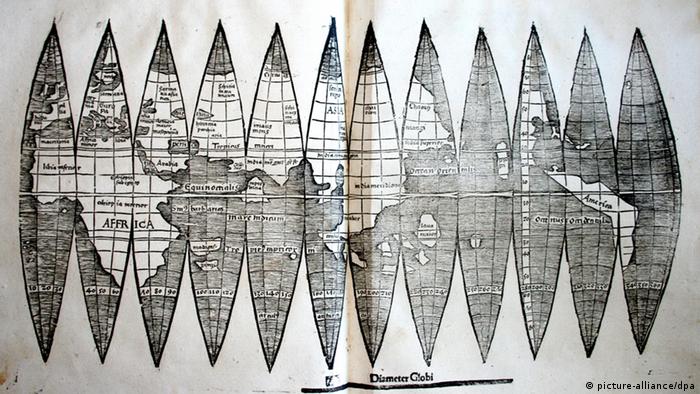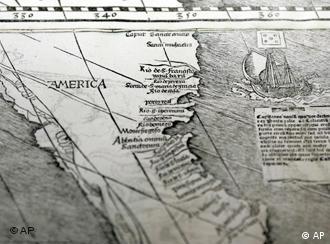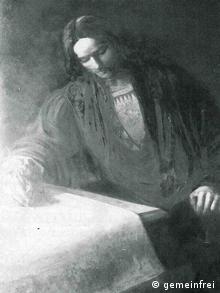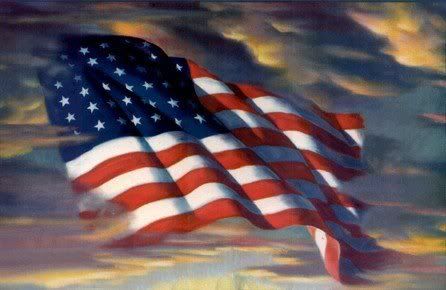
Posted on 07/04/2012 6:59:28 AM PDT by NYer

Munich librarians have found a rare 16th century world map that first gave America its name as a continent. The version by German cartographer Martin Waldseemüller survived World War II sandwiched between geometry books.
The Munich version is smaller than the 500-year-old global map found in a German monastery in 1901 and handed over by German Chancellor Angela Merkel in 2007 to the US Library of Congress. Only four smaller versions were previously known to have survived.

The word "America" on the larger Library of Congress map
Waldseemüller (1470 – 1522) was the first cartographer to depict America as a separate continent on a global map and to name it after the Italian seafaring explorer Amerigo Vespucci. In his journals, Vespucci had described the eastern coast of what he saw as a new continent, which we now know is South America.
The Florentine navigator Vespucci was a younger contemporary of Christopher Columbus, the Italian in Spanish service who reached Central America in 1492 believing it was part of Asia while searching for a western trade route.
"We've made a sensational find," said Klaus-Rainer Brintzinger, the director of Munich's Ludwig-Maximilian University's library, referring to the latest Waldseemüller map to re-emerge.
The head of the university library's section for ancient books, Sven Kuttner said "there hasn't been a find of this dimension since World War II."

Martin Waldseemüller
Several days ago, two women involved in catalogue correction at the library opened a bound 19th century folio containing two printed geometry works. Sandwiched between them was the smaller A4-sized Waldseemüller map, the university said in a statement.
The folio had been bound together by Viennese librarians in 1871, and they apparently did not recognize the map's significance.
"So the bound folio sank into a long hibernation," said Kuttner.
When the Munich university library was burnt during World War II, the folio, including the map, had already been removed to safety in an air-tight box with the number 340. It ended up in the eastern Bavarian city of Landshut. In 1955 the box was returned to Munich where it sat unnoticed in a university archive.
Kuttner said the Munich find differs slightly from the other known versions of Waldseemüller's maps. For example, the 1498 landing site of the Portuguese Vasco de Gama at Calicut in southern India is drawn of the map's fourth segment, not on the fifth segment as on other versions.
"It can be regarded as a unicum," said Kuttner.

I don’t see the Outer Banks NC on it!
I've heard this referred to as "America's Birth Certificate". Funny, they can find an obscure 500 years old BC for the new world, but can't find one in Hawaii for a usurper!
|
|
|
| GGG managers are SunkenCiv, StayAt HomeMother & Ernest_at_the_Beach | |

|
|
Thanks NYer. Martin Waldseemüller map ping. BTW, occasionally one will still see the completely fabricated lie that the Americas were not named of/by/for Amerigo Vespucci, don't ever believe it. |
|
|
|
|
Interesting south America is not represented at all.... I thought it was a known entity at that time the-map was drawn
Great piece of history, looks like South America.


I call bogus -- the typeface of 'AMERICA' was not one normally used by 16th Century German cartographers.....

LOL! Proportional spacing!
LOL! Proportional spacing!
BINGO!
'-)
That cat doesn’t seem to rind, er, mind. They’re so patient with us.

;’)
Disclaimer: Opinions posted on Free Republic are those of the individual posters and do not necessarily represent the opinion of Free Republic or its management. All materials posted herein are protected by copyright law and the exemption for fair use of copyrighted works.